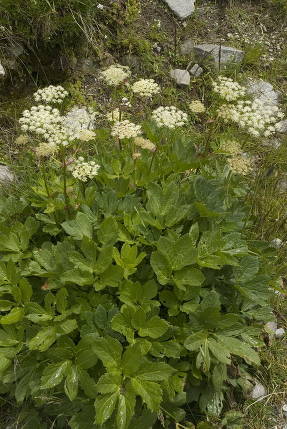Nasturtium horticultural (Peucedanum ostruthium) belongs to the flora of Western Europe, but is not found everywhere. This plant feels good only high in the mountains (in the Alps - above 1000 m, rarely - below), prefers calcareous soils and silica of mountain meadows, the banks of mountain streams, shrubs with moist soils.
The Latin name for gorichnogo comes from the Greek peukedanonwhich means "pork fennel" or "parsnip".
There are also popular names: master's root, royal root, royal root, siren root, Adam's rib.
Botanical portrait

Nasturtium horticultural (Peucedanum ostruthium) - herbaceous perennial plant of the celery family, or umbelliferae (Apiaceae), growing in height from 40 to 100 cm. It has a straight, slightly leafy round stem with grooves. From a spindle-shaped thick brown rhizome, similar in shape to a carrot with many shoots, numerous thin underground shoots depart. In spring, scales grow at the base of the stem, forming the so-called "crown". Leaves glabrous or rough underneath, once or twice triple-pinnate. The flowers are small, usually white (less often red) in color, collected in large multi-flowered 40-50-ray umbrellas 10-15 cm in diameter. The teeth of the calyx are invisible, the petals are white or reddish, broadly obovate. Blooms from June to August. The fruits are almost round, 4-5 mm long and the same width.
Absolutely all parts of the nasturtium horticultural plant have a very strong odor, strongly reminiscent of the smell of celery or angelica. The rhizome of the plant is especially fragrant. Young stems and root are edible. The leaves can also be eaten after being cooked. The plant is used as a flavoring additive - it is believed that the horticultural is tastier than the pepper.
Cultivation of a horticultural plant
The nasturtium horticultural plant on the site can be grown in fertile soil, which must be well drained. It can grow both in direct sun and in partial shade. Needs regular watering, the soil should not completely dry out between waterings.
The plant is propagated by dividing or by seeds, planted at a distance of 40-60 cm.
An allergic reaction can occur when handling the plant with bare hands, for this reason, sensitive people need to wear gloves.
The plant is winter-hardy up to -28 degrees, so it is mulched for the winter.

Goryanny is not only a source of valuable medicinal raw materials, but also a very ornamental plant. In gardens, its variegated Daphnis form with a white border around the edge of the leaf is often used.
Umbrellas and leaves are an excellent cutting material for fragrant summer bouquets.
Continued - in the article Medicinal horticultural.









